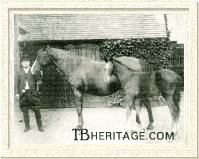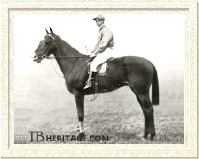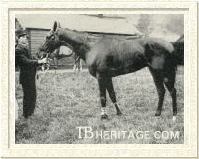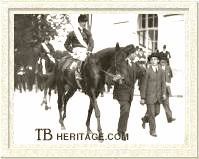|
|
St. Frusquin

|
|
 |
|
|
One of the more celebrated racing rivalries of the 19th century took place in 1896, between two outstanding sons of leading sire St. Simon: Persimmon and St. Frusquin. They were the first classic winning colts by their famous sire, from his seventh crop. Both later went on in the stud to become leading sires of classic winners themselves.
St. Frusquin was bred and raced by Leopold de Rothschild, a member of the famed European banking family. The Rothschild family had been prominent on the British turf for most of the century, their colors carried by such horses as King Tom, Tormentor, Hannah, Sir Bevys and a score of others. "Mr. Leopold," one of the most popular members of the Jockey Club, was a long-time friend of Persimmon's owner and breeder, the Prince of Wales, who had attended Rothschild's 1881 wedding to Marie Perugia. Rothschild's British breeding establishment, Southcourt Stud, was near the town of Leighton Buzzard, in Bedfordshire.
|

Isabel
| | The dam of St. Frusquin, Isabel, was modestly bred, being by Plebeian, who only ran once, winning the Middle Park Stakes, and out of a daughter of Parmesan. Isabel had been a decent enough filly on the track, winning eleven races, including the Queen's Plate and the Summer Cup at Newmarket. As a broodmare, St. Frusquin was her best offspring, though before him she had produced the stakes winners Mirabelle and High Havens.
|
St. Frusquin was a medium size brown colt with a star and snip on his face, top-heavy and on the leg; he had none of the sleekness and elegance of his rival, Persimmon. He was a precocious colt, but was also unsound most of his life. During his racing career, he suffered from rheumatism, which at one time knocked him out of training for a few months. But when he was right, he was a very high class colt, defeated only twice in his eleven starts, finishing second both those times.
Trained at Newmarket by Alfred Hayhoe, St. Frusquin quickly established himself as one of the best young colts in the country with his juvenile campaign. He came out for the first time at Kempton Park, in the Royal Two-Year-Old Plate, and won easily. Then came victories in the Sandringham Gold Cup at Sandown and the Chesterfield Stakes, run at Newmarket.
St. Frusquin was out of action for three months with a bad bout of rheumatism, and when he re-emerged in the Imperial Produce Stakes, he finished second by half a length to a horse called Teufel, who carried 124 pounds to the 136 pound burden laid on St. Frusquin. He then entered the winner's enclosure again, for the Middle Park Plate. Third in that race was Persimmon, who had shown considerable promise on the track for his owner, the Prince of Wales. He had won his two previous starts--the Coventry Stakes and the Richmond Stakes. He ran below his best form in the Middle Park, as he was suffering the effects of a cough. The rivalry between the two sons of St. Simon would blossom the next season. St. Frusquin went on to finish his juvenile year with an easy victory in the Dewhurst Plate, carrying 131 pounds.
At age three, St. Frusquin started the season with a win in the Column Produce Stakes, and then went on to easily take the Two Thousand Guineas. He was then prepared to take on Persimmon and ten others in the Derby at Epsom. St. Frusquin was the favorite over Persimmon, but then the Prince's colt was making his first start since being beaten by St. Frusquin the previous autumn.
The two St. Simon colts were expected to have the race between them, and that is how it ensued. St. Frusquin held the advantage until about a furlong out, and then was challenged by Persimmon. The two horses battled through the straight until Persimmon, even after a slight bobble, gained a slight lead and went under the wire a neck in front of his rival. There were tremendous cheers from the crowd for the victory of the Prince of Wales in the classic race, but St. Frusquin lost nothing in defeat. |

St. Frusquin at Age 3
| | The next race between the two took place at Newmarket, in the Princess of Wales' Stakes. This time, it was St. Frusquin, getting three pounds from Persimmon, who emerged victorious. The margin of victory was half a length. Sadly, this was the last time the two would ever meet. Persimmon was put away until the St. Leger. The Eclipse Stakes at Sandown Park was then basically left to the mercy of the Rothschild colt. The two St. Simon colts had met three times, with St. Frusquin emerging the victor twice.
|
| A fine field of four went to post for the Eclipse. The Duke of Westminster entered a beautifully bred pair--Regret, a stakes winning son of Sheen-Farewell, and Labrador, a good third to St. Frusquin in the Two Thousand Guineas, who was by Sheen, and out of Ornament. The other entrant was the Duke of Portland's Troon, a full brother to Derby winner Ayrshire, and a major winner in his own right. Before his untimely death that same year, Troon accounted for the St. James Palace Stakes and the Sussex Stakes. St. Frusquin stalked until late in the race, and then passed Regret and Troon to win very easily by one and a half lengths. |
| St. Frusquin's Race Record |
| Year | Age | Starts | 1st | 2nd | 3rd |
| 1895 | 2 | 6 | 5 | 1 | 0 |
| 1896 | 3 | 5 | 4 | 1 | 0 |
| Total | -- | 11 | 9 | 2 | 0 |
| | After the Eclipse Stakes, a rematch against Persimmon was eagerly awaited. Before that could happen, St. Frusquin broke down during training for the St. Leger. The injury to the delicate colt was sprained suspensory ligaments in both forelegs. There was no choice but to retire him to stud. He was sent back to Rothschild's Southcourt Stud, while Persimmon went on to glory in the St. Leger that fall and the Ascot Gold Cup and Eclipse Stakes the next summer.
|
St. Frusquin in the Stud
St. Frusquin enjoyed a long, successful stud career. He was leading sire twice, compared to Persimmon's four times, but then St. Frusquin came up with six classic winners, compared to Persimmon's five. The classic winners sired by St. Frusquin were: the unbeaten filly, QUINTESSENCE, winner of the One Thousand Guineas; ST. AMANT, winner of the Two Thousand Guineas and Derby; FLAIR, a winner of the One Thousand Guineas; RHODORA, also a winner of the One Thousand Guineas and a half-sister to the Derby winner Orby; ROSEDROP, a winner of the Oaks; and MIRSKA, also an Oaks champion. |

St. Amant in Training

Ecouen

Greenback
| | ST. AMANT (from Lady Loverule by Muncaster) was a sentimental winner of the Derby, bred and raced by the owner of his sire, "Mr. Leopold," who was very popular with the English racing public. The race was run in a fierce thunderstorm, which the old gentleman braved without cover to see the son of his beloved St. Frusquin win over a fine field that included John o' Gaunt, Gouvernant, and St. Denis. Soaking wet, horse, jockey, and proud owner, were greeted with enthusiastic cheers and applause as they made their way into the winner's enclosure. St. Amant also won the Two Thousand Guineas and the Jockey Club Stakes at age 3.
St. Amant was a useful stallion - he produced a few nice winners, including Chacolet, two-time champion handicap mare in the U.S.
Other St. Frusquin sons included ECOUEN, winner in France of the Grand Criterium, the Prix des Cars, second in the Poule d'Essai, and winner of the Prix Daru and the Prix Lupin, later the sire of the 1928 Grand Steeplechase de Paris winner Maguelonne and broodmare sire of Grand Prix de Paris winner Take My Tip. Another St. Frusquin son was SAINT JUST, winner in France of the Prix Conde and other races, and later sire of the good winners Stearine, Highborn, and Jus de Raisin. The brothers PIETRI and LORENZO, both by St. Frusquin, were good performers: the former was a good juvenile winner of the Gimcrack Stakes and Doncaster's Champagne Stakes among other races , and the latter a good stayer that won the Manchester Cup and Liverpool Autumn Cup. Both PIETRI AND LORENZO went to stud in South Africa, where they got stakes winners, and PIETRI was leading sire there in 1922.
Other St. Frusquin sons that did well as stallions included ST. WOLF, winner of Ascot's New Stakes and the Newmarket Stakes; he was sent to stud in Argentina where he was four times champion sire there, and a dominating broodmare sire that led that list four times. Other good St. Frusquin sire sons included ST. ANTON, a successful stallion in Australia; ST. CYR, a good sire in South Africa, and GREENBACK, winner of the Price of Wales's Stakes and other races and later sire of Paper Money, a champion stallion in New Zealand.
|
Many of St. Frusquin's daughters were worth their weight in gold to breeders fortunate enough to have one in their broodmare herd. Oaks winner QUINTESSENCE, from Margarine by Petrarch, produced Clarissimus, a Radium colt which won the Two Thousand Guineas. She also produced two more classics-placed performers.
|

Quintessence

Rosedrop

Rhodora
| | ROSEDROP (1907), winner of the Oaks and the Great Yorkshire Stakes, was from the Trenton mare Rosaline. She produced a strapping bay colt by Bayardo. Named Gainsborough, he won a wartime Triple Crown. Gainsborough became a leading stallion, his best progeny being Lord Derby's Hyperion, a classic-winning champion and one of the most dominant stallions of his era.
St. Frusquin's classics-placed daughter SALAMANDRA (from Electra, by Eager) produced a colt by the speedy The Tetrarch named Salmon Trout. This colt had the stamina to capture the St. Leger. Another daughter, SWEET BRIAR II, was imported to the United States and her blood was influential in American breeding.
Sweet Briar's two sons by Sundridge were Sun Briar and Sunreigh. Sun Briar was the pride and joy of owner Willis Sharpe Kilmer before Exterminator entered his stable. Sun Briar captured the Travers Stakes and later sired Sun Beau, a handicap star of the Depression era and longtime holder of the title "world's leading money earner."
Sunreigh is known as the sire of Reigh Count, winner of the Kentucky Derby, and of the Coronation Cup in England as a four-year-old. Reigh Count was inbred to St. Frusquin, as his second dam, Pitti, was by him. Therefore, Reigh Count's finest son, American Triple Crown champion Count Fleet, was also inbred to St. Frusquin. Count Fleet also had Persimmon as an ancestor. At any rate, he was just as fine a sire as a racer, with his own Kentucky Derby champion, Count Turf, and champions like One Count, Counterpoint, and Kiss Me Kate among his progeny.
St. Frusquin's daughter, RHODORA (1905), captured the Dewhurst Stakes and the One Thousand Guineas, and seemed like a sure thing for the Oaks, but was brought down by Partridge, when that filly fell directly in her path. That race was won by Signorinetta. Rhodora's career as a broodmare was just as unfortunate. Barren for several years, she suffered a severe dystocia in 1913, during which the foal had to be cut out of her in pieces. Sold after that by her owner, Richard Croker, to Donald Fraser, she fared no better. Fraser bought her knowing he was taking a major risk; she caught to the Sundridge son, White Magic, and foaled a chestnut colt in 1917, but the foal was not sound and was put down. Unable to get Rhodora in foal again, late in 1921 Fraser had her destroyed. St. Frusquin's classic winning daughter was then fed to Fraser's hounds.
|
St. Frusquin's finest producing daughter was probably POPINJAY, foaled in 1905 from the wonderful racemare, Chelandry. She only placed third in two races, the Coventry Stakes and the Cheveley Park Stakes, but she became a broodmare of the highest order for her owner, Lord Astor. She herself produced a few classic-placed runners--Magpie, Pompadour, and Gay Bird. But her daughters produced classic winners.
Popinjay's daughter by Dark Ronald, Popingaol, produced two fine fillies--Pogrom, an Oaks winner, and Book Law, a versatile filly which counted among her victories the one mile Coronation Stakes and the St. Leger. Book Law, in her turn, produced Eclipse champion and major sire Rhodes Scholar; Archive, the sire of chasing sensation Arkle; and Highway Code. The latter, a filly, imported to the United States by Bull Hancock of Claiborne Farm, became a foundation mare in her own right, with such illustrious descendants as Swale, Forty Niner, and Shadeed. Book Law had a full sister, Book Debt, which did not amount to anything as a runner, but, bred to Fairway, she produced a Two Thousand Guineas winner in the colt Pay Up.
Good and Gay, Popinjay's daughter by Bayardo, produced full siblings by Swynford--the good sire Sure and Swift, and One Thousand Guineas and Oaks victress Saucy Sue. Good and Gay's three-quarter sister, Gay Bird, by Gay Crusader, became the second dam of the French champion colt Clarion.
St. Frusquin outlived his rival, Persimmon, by several years. Persimmon died in 1908 at the age of fifteen. St. Frusquin developed a wart on his genitals that interfered with his ability to breed, and although perfectly healthy otherwise, he was humanely destroyed at the age of twenty-one, on August 25, 1914.
-- by Elizabeth Martiniak
|
|
|
|

